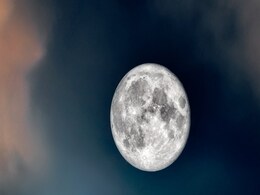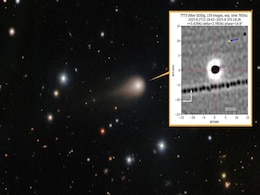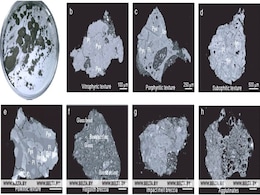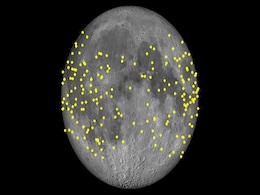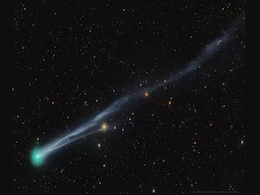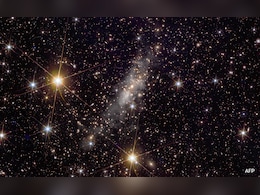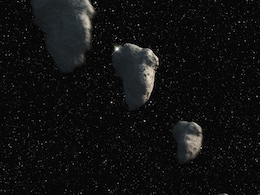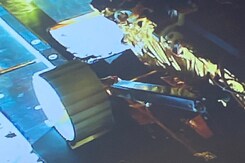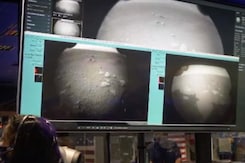Space Dust
- All
- News
- Videos
-

Interstellar Comet 3I/ATLAS Nears Earth on Dec. 19, Offering Rare Insights Into Cosmic Visitors
- Wednesday December 17, 2025
Interstellar comet 3I/ATLAS will make its closest approach to Earth on Dec. 19. Observing the comet provides scientists a rare opportunity to study dust and gases from its icy nucleus and learn more about material forming around other stars, expanding understanding of interstellar objects while posing no threat to our planet.
-
 www.gadgets360.com
www.gadgets360.com
-

Supermoon and Geminid Meteor Shower 2025 Set to Peak Soon: How to See It
- Thursday December 4, 2025
The 2025 Geminid meteor shower peaks on December 13–14, offering bright, frequent meteors under dark skies thanks to a thin crescent Moon. Originating from asteroid 3200 Phaethon, the Geminids can produce over 100 meteors per hour. Best viewing is after midnight from clear, dark locations.
-
 www.gadgets360.com
www.gadgets360.com
-

NASA’s Perseverance Records First-Ever Mini-Lightning on Mars
- Tuesday December 2, 2025
NASA’s Perseverance rover has captured the first confirmed mini-lightning sparks in Mars’ dusty atmosphere. Using its sensitive microphone, the rover recorded 55 tiny electrical discharges during dust storms over two Martian years. These sparks generate reactive chemicals that can break down organic molecules, affecting future life-detection ef...
-
 www.gadgets360.com
www.gadgets360.com
-

Webb’s Stunning View of Apep Shows a Rare Triple-Star System Wrapped in Spirals
- Sunday November 23, 2025
Webb’s mid-infrared images of Apep reveal a rare triple-star system producing vast carbon-rich dust spirals from colliding stellar winds. The two Wolf–Rayet stars and a distant supergiant create layered shells that record centuries of activity and enrich the galaxy with elements vital for future stars and planets.
-
 www.gadgets360.com
www.gadgets360.com
-

Scientists Just Solved the Mystery of the Moon’s Lopsided Dust Halo
- Sunday November 9, 2025
Scientists have solved why the Moon’s dust cloud is uneven: heat. Using computer models, researchers found that meteor impacts on the Moon’s sunlit surface fling 6–8% more dust into space than on the cold night side, creating a lopsided halo. NASA warns this dust could threaten future landers and astronauts.
-
 www.gadgets360.com
www.gadgets360.com
-

Astronomers Spot Signs of Baby Planets in a Star’s Mysterious Disk
- Friday November 7, 2025
Astronomers using Keck Observatory have imaged the dusty disk around HD 34282, a young star about 400 light-years away, revealing bright clumps and a 40 AU gap—clear signs of planet formation. The system provides a rare glimpse into early planetary birth, helping refine models of how gas and dust evolve into new worlds.
-
 www.gadgets360.com
www.gadgets360.com
-

Sandisk Creator Phone SSD Review: Snap, Shoot, and Edit on the Go
- Monday November 3, 2025
The Sandisk Creator Phone SSD is available in 1TB and 2TB storage options. It comes in a single colour option - Blue, which may get dirty over time. The device targets content creators and solves one of the biggest hassles of space crunch. It also receives a direct-to-drive storage option and an IP65 rating for water and dust resistance. However, i...
-
 www.gadgets360.com
www.gadgets360.com
-

New Images of Interstellar Object 3I/ATLAS Show a Giant Jet Shooting Toward the Sun
- Sunday October 26, 2025
New telescope images show interstellar comet 3I/ATLAS ejecting a giant jet of gas and dust toward the Sun. Scientists say the phenomenon confirms its natural cometary behaviour, offering clues about how such ancient interstellar visitors react to solar heat.
-
 www.gadgets360.com
www.gadgets360.com
-

Chang’e-6 Lunar Samples Reveal Water-Rich Asteroid Fragments
- Saturday October 25, 2025
Analysis of Chang’e-6 lunar dust uncovered microscopic carbonaceous chondrite fragments—evidence of water-bearing asteroids that once struck the Moon. The discovery indicates a far greater delivery of water and organics to Earth and the Moon than thought, helping scientists refine theories about the solar system’s early volatile sources.
-
 www.gadgets360.com
www.gadgets360.com
-

NASA and ESA Trace Mysterious Lunar Flashes to Meteors and Gas Leaks
- Wednesday October 22, 2025
Transient Lunar Phenomena are mysterious bursts and glows observed on the Moon, lasting from milliseconds to hours. NASA and ESA research show that these events often result from meteoroid impacts, radon gas outgassing, and dust charged by solar wind, illuminating the Moon’s dynamic surface in surprising ways.
-
 www.gadgets360.com
www.gadgets360.com
-

Honor Earbuds 4 Launched With Up to 50dB ANC, Up to 46 Hours of Total Battery Life: Price, Features
- Wednesday October 15, 2025
Honor Earbuds 4 feature a traditional in-ear design with a dual-tone finish and touch controls, including volume adjustment via slide controls. They use 11mm + 6mm titanium-plated dynamic drivers and support up to 50dB ANC with dual transparency mode. The earbuds include in-ear detection, AI three-mic noise reduction, and 20Hz–20kHz frequency res...
-
 www.gadgets360.com
www.gadgets360.com
-

Astrophotographer Captures Stunning “Raging Baboon Nebula” in Deep Space
- Wednesday October 22, 2025
A stunning new image by Greg Meyer shows the “Raging Baboon Nebula” in Corona Australis, about 500 light-years away. Captured over 13 nights at Starfront Observatory in Texas, the photo reveals a baboon-like face formed by blue reflection nebulae and dark molecular dust.
-
 www.gadgets360.com
www.gadgets360.com
-

Strange 'Rogue' Planet Spotted Guzzling Matter Like A Star
- Thursday October 2, 2025
- Science | AFP
A mysterious "rogue" planet has been observed gobbling six billion tonnes of gas and dust a second -- an unprecedented rate that blurs the line between planets and stars, astronomers said.
-
 www.ndtv.com
www.ndtv.com
-

Asteroid Belt Is Slowly Fading, Study Finds
- Tuesday September 30, 2025
- Science |
A recent study shows the asteroid belt is slowly losing material due to gravitational forces and collisions, with implications for Earth's past and future impact risks.
-
 www.ndtv.com
www.ndtv.com
-

Interstellar Comet 3I/ATLAS Nears Earth on Dec. 19, Offering Rare Insights Into Cosmic Visitors
- Wednesday December 17, 2025
Interstellar comet 3I/ATLAS will make its closest approach to Earth on Dec. 19. Observing the comet provides scientists a rare opportunity to study dust and gases from its icy nucleus and learn more about material forming around other stars, expanding understanding of interstellar objects while posing no threat to our planet.
-
 www.gadgets360.com
www.gadgets360.com
-

Supermoon and Geminid Meteor Shower 2025 Set to Peak Soon: How to See It
- Thursday December 4, 2025
The 2025 Geminid meteor shower peaks on December 13–14, offering bright, frequent meteors under dark skies thanks to a thin crescent Moon. Originating from asteroid 3200 Phaethon, the Geminids can produce over 100 meteors per hour. Best viewing is after midnight from clear, dark locations.
-
 www.gadgets360.com
www.gadgets360.com
-

NASA’s Perseverance Records First-Ever Mini-Lightning on Mars
- Tuesday December 2, 2025
NASA’s Perseverance rover has captured the first confirmed mini-lightning sparks in Mars’ dusty atmosphere. Using its sensitive microphone, the rover recorded 55 tiny electrical discharges during dust storms over two Martian years. These sparks generate reactive chemicals that can break down organic molecules, affecting future life-detection ef...
-
 www.gadgets360.com
www.gadgets360.com
-

Webb’s Stunning View of Apep Shows a Rare Triple-Star System Wrapped in Spirals
- Sunday November 23, 2025
Webb’s mid-infrared images of Apep reveal a rare triple-star system producing vast carbon-rich dust spirals from colliding stellar winds. The two Wolf–Rayet stars and a distant supergiant create layered shells that record centuries of activity and enrich the galaxy with elements vital for future stars and planets.
-
 www.gadgets360.com
www.gadgets360.com
-

Scientists Just Solved the Mystery of the Moon’s Lopsided Dust Halo
- Sunday November 9, 2025
Scientists have solved why the Moon’s dust cloud is uneven: heat. Using computer models, researchers found that meteor impacts on the Moon’s sunlit surface fling 6–8% more dust into space than on the cold night side, creating a lopsided halo. NASA warns this dust could threaten future landers and astronauts.
-
 www.gadgets360.com
www.gadgets360.com
-

Astronomers Spot Signs of Baby Planets in a Star’s Mysterious Disk
- Friday November 7, 2025
Astronomers using Keck Observatory have imaged the dusty disk around HD 34282, a young star about 400 light-years away, revealing bright clumps and a 40 AU gap—clear signs of planet formation. The system provides a rare glimpse into early planetary birth, helping refine models of how gas and dust evolve into new worlds.
-
 www.gadgets360.com
www.gadgets360.com
-

Sandisk Creator Phone SSD Review: Snap, Shoot, and Edit on the Go
- Monday November 3, 2025
The Sandisk Creator Phone SSD is available in 1TB and 2TB storage options. It comes in a single colour option - Blue, which may get dirty over time. The device targets content creators and solves one of the biggest hassles of space crunch. It also receives a direct-to-drive storage option and an IP65 rating for water and dust resistance. However, i...
-
 www.gadgets360.com
www.gadgets360.com
-

New Images of Interstellar Object 3I/ATLAS Show a Giant Jet Shooting Toward the Sun
- Sunday October 26, 2025
New telescope images show interstellar comet 3I/ATLAS ejecting a giant jet of gas and dust toward the Sun. Scientists say the phenomenon confirms its natural cometary behaviour, offering clues about how such ancient interstellar visitors react to solar heat.
-
 www.gadgets360.com
www.gadgets360.com
-

Chang’e-6 Lunar Samples Reveal Water-Rich Asteroid Fragments
- Saturday October 25, 2025
Analysis of Chang’e-6 lunar dust uncovered microscopic carbonaceous chondrite fragments—evidence of water-bearing asteroids that once struck the Moon. The discovery indicates a far greater delivery of water and organics to Earth and the Moon than thought, helping scientists refine theories about the solar system’s early volatile sources.
-
 www.gadgets360.com
www.gadgets360.com
-

NASA and ESA Trace Mysterious Lunar Flashes to Meteors and Gas Leaks
- Wednesday October 22, 2025
Transient Lunar Phenomena are mysterious bursts and glows observed on the Moon, lasting from milliseconds to hours. NASA and ESA research show that these events often result from meteoroid impacts, radon gas outgassing, and dust charged by solar wind, illuminating the Moon’s dynamic surface in surprising ways.
-
 www.gadgets360.com
www.gadgets360.com
-

Honor Earbuds 4 Launched With Up to 50dB ANC, Up to 46 Hours of Total Battery Life: Price, Features
- Wednesday October 15, 2025
Honor Earbuds 4 feature a traditional in-ear design with a dual-tone finish and touch controls, including volume adjustment via slide controls. They use 11mm + 6mm titanium-plated dynamic drivers and support up to 50dB ANC with dual transparency mode. The earbuds include in-ear detection, AI three-mic noise reduction, and 20Hz–20kHz frequency res...
-
 www.gadgets360.com
www.gadgets360.com
-

Astrophotographer Captures Stunning “Raging Baboon Nebula” in Deep Space
- Wednesday October 22, 2025
A stunning new image by Greg Meyer shows the “Raging Baboon Nebula” in Corona Australis, about 500 light-years away. Captured over 13 nights at Starfront Observatory in Texas, the photo reveals a baboon-like face formed by blue reflection nebulae and dark molecular dust.
-
 www.gadgets360.com
www.gadgets360.com
-

Strange 'Rogue' Planet Spotted Guzzling Matter Like A Star
- Thursday October 2, 2025
- Science | AFP
A mysterious "rogue" planet has been observed gobbling six billion tonnes of gas and dust a second -- an unprecedented rate that blurs the line between planets and stars, astronomers said.
-
 www.ndtv.com
www.ndtv.com
-

Asteroid Belt Is Slowly Fading, Study Finds
- Tuesday September 30, 2025
- Science |
A recent study shows the asteroid belt is slowly losing material due to gravitational forces and collisions, with implications for Earth's past and future impact risks.
-
 www.ndtv.com
www.ndtv.com


